I live in a concrete, earth covered home. It currently has a 40 year old kozy heat wood stove installed in the center of the home. It has a 5' vertical run of single wall black pipe coming directly off of the stove. Beyond this, it passes through about 2.5' of concrete. The piping through here is 8" stainless that has about 3/4" heat resistant insulation around it. After the short run of stainless, it transitions to about another 6' of 9x9 clay lined masonry. Upon cleaning this year, my brush pulled up a jagged piece of metal. Disassembly of the interior piping shows that the stainless pipe is rotted at one of the joints, about 2' up the chase. My plan was to replace the stainless but now considering getting a new stove. The new stoves all seem to use a 6" flue so there should be room to pull in some type of liner. I am looking for some insight on the best system to use. I believe that it would need to be insulated although the chimney never comes anywhere near any combustibles. This also makes me wonder if i could just install standard double wall pipe through the old chimney chase. The major obstacle I am seeing is that I need to transition from double wall black pipe to the liner at the concrete ceiling. I would like something that is aesthetically pleasing and somewhat serviceable. Of the systems I've looked at, they all seem to use masonry thimbles that are meant for horizontal install and not vertical. I will add some photos if that would help. Thanks for any tips!
Chimney relining options for an earth sheltered home
- Thread starter kevin588127
- Start date
-
Active since 1995, Hearth.com is THE place on the internet for free information and advice about wood stoves, pellet stoves and other energy saving equipment.
We strive to provide opinions, articles, discussions and history related to Hearth Products and in a more general sense, energy issues.
We promote the EFFICIENT, RESPONSIBLE, CLEAN and SAFE use of all fuels, whether renewable or fossil.
You are using an out of date browser. It may not display this or other websites correctly.
You should upgrade or use an alternative browser.
You should upgrade or use an alternative browser.
30WCF
Minister of Fire
Photos would be helpful for sure.
Is concrete the visible ceiling , or is there some type of finished drop ceiling or drywall?
Is concrete the visible ceiling , or is there some type of finished drop ceiling or drywall?
I'll add some tonight. ceiling is precast concrete. only finish is paint. Eventually, when I remodel the area, I will fir it down an inch and a half and insulate and drywall. So ideally I should probably do an insulated thimble.Photos would be helpful for sure.
Is concrete the visible ceiling , or is there some type of finished drop ceiling or drywall?
Here are the pictures. I had wrongfully assumed that it was 9x9 as they have a piece of 8" stainless pipe butted up to it. It is actually 8x8 clay tile. Internal diameter is 6.75". This would make an insulated 6" liner difficult. Total length of the chimney (face of the ceiling to top of the clay liner) is 110.5". 39" of that is poured and precast concrete that has the 8" round stainless pipe leaves through it.
Rockford chimney sells a solid 6" liner that looks appealing and I'm wondering if I would even need to install insulation though they offer a .25" insulation.
Duravent offers a product called that duraliner that may fit the bill as well.
Any advice is greatly appreciated!
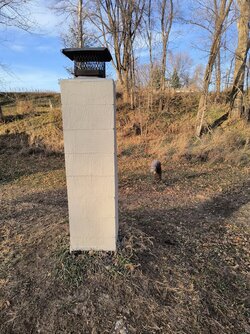
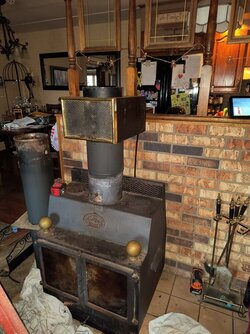
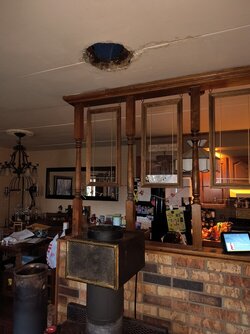
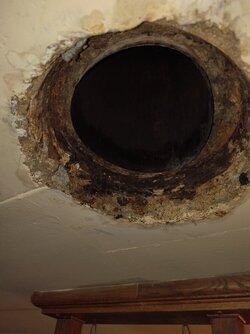
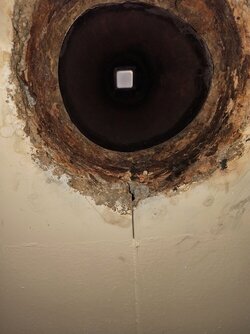
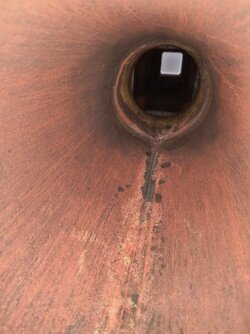
Rockford chimney sells a solid 6" liner that looks appealing and I'm wondering if I would even need to install insulation though they offer a .25" insulation.
Duravent offers a product called that duraliner that may fit the bill as well.
Any advice is greatly appreciated!






Last edited:
Just break out the clay and install a proper insulated linerHere are the pictures. I had wrongfully assumed that it was 9x9 as they have a piece of 8" stainless pipe butted up to it. It is actually 8x8 clay tile. Internal diameter is 6.75". This would make an insulated 6" liner difficult. Total length of the chimney (face of the ceiling to top of the clay liner) is 110.5". 39" of that is poured and precast concrete that has the 8" round stainless pipe leaves through it.
Rockford chimney sells a solid 6" liner that looks appealing and I'm wondering if I would even need to install insulation though they offer a .25" insulation.
Duravent offers a product called that duraliner that may fit the bill as well.
Any advice is greatly appreciated!
View attachment 320269 View attachment 320270 View attachment 320271 View attachment 320272 View attachment 320273 View attachment 320274
30WCF
Minister of Fire
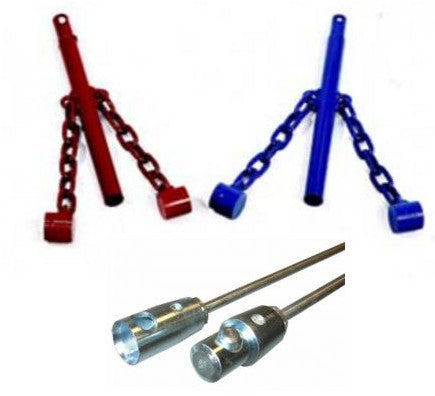
Chimney Clay Tile Breaker | Clay Flue Tile Breaker Tool
A Chimney Clay Tile Breaker removes clay flue tiles quickly & easier than any tool. The weighted system spins & effectively breaks up clay flue tiles.
Thanks for the replies. Breaking the liner out doesn't look to be a major ordeal as there isn't much of it and its pretty easy to access. So this leads me to another question. This project was completely unplanned at this time and a future remodel is going to happen. With that in mind, would it be possible to install an 8" liner that would allow me to use the current woodstove for a few years? Then a few years down the line when we figure out what we actually want to do with the area, purchase a new stove that would likely have a 6" flue. Changing to a a new wood stove now is going to require extending the hearth and revamping the air intake.
30WCF
Minister of Fire
Not sure what the rest of the exterior looks like, but it would be cool to do some sculpting around that chimney and make it look like a broken off tree stump.
So I I just had the only local installer come out and take a look. They are a hearthstone dealer. As an electrician I worked on a few projects with the estimator that they sent out and from what I know of him (on the HVAC side of things), he usually knows his stuff. He answered all of my questions and gave me a quote. Prices on material were right in line with what I was finding through my own research and he was quoting quality stuff. Duratech double wall inside piping, transitioning to heavy wall flexible stainless. At the end of the visit I think we have a pretty solid plan.
BUT...
The hearthstone line are all Catalytic stoves. This is something I hadn't even considered due to the added complexity. He told me about the added efficiency and how clean they burn, ECT. I'm just wondering if that is the truth on these stoves. He did mention that you have to learn how to operate them.
He also spec'd out non insulated liner. Everything I've researched says to insulate if you could. I mentioned breaking out the liner to accommodate an insulated liner and he went on to explain that in this particular install, insulation wouldn't be required for clearance and he actually preferred to put in non insulated. I'm a bit puzzled by that.
Any thoughts?
BUT...
The hearthstone line are all Catalytic stoves. This is something I hadn't even considered due to the added complexity. He told me about the added efficiency and how clean they burn, ECT. I'm just wondering if that is the truth on these stoves. He did mention that you have to learn how to operate them.
He also spec'd out non insulated liner. Everything I've researched says to insulate if you could. I mentioned breaking out the liner to accommodate an insulated liner and he went on to explain that in this particular install, insulation wouldn't be required for clearance and he actually preferred to put in non insulated. I'm a bit puzzled by that.
Any thoughts?
Installing non-insulated saves him work. No liner removal. No insulation install.
May as well do some in-depth Hearthstone research here on Hearth as long as you're at it. Look at the models your fella is recommending.
Your making progress.
If you want PM where you are located in this fine state
May as well do some in-depth Hearthstone research here on Hearth as long as you're at it. Look at the models your fella is recommending.
Your making progress.
If you want PM where you are located in this fine state

Did he explain why he prefers uninsulated? The only reason I can.think of is that it's easier and cheaper.So I I just had the only local installer come out and take a look. They are a hearthstone dealer. As an electrician I worked on a few projects with the estimator that they sent out and from what I know of him (on the HVAC side of things), he usually knows his stuff. He answered all of my questions and gave me a quote. Prices on material were right in line with what I was finding through my own research and he was quoting quality stuff. Duratech double wall inside piping, transitioning to heavy wall flexible stainless. At the end of the visit I think we have a pretty solid plan.
BUT...
The hearthstone line are all Catalytic stoves. This is something I hadn't even considered due to the added complexity. He told me about the added efficiency and how clean they burn, ECT. I'm just wondering if that is the truth on these stoves. He did mention that you have to learn how to operate them.
He also spec'd out non insulated liner. Everything I've researched says to insulate if you could. I mentioned breaking out the liner to accommodate an insulated liner and he went on to explain that in this particular install, insulation wouldn't be required for clearance and he actually preferred to put in non insulated. I'm a bit puzzled by that.
Any thoughts?
He said that he thought the insulated liner could actually lead to condensation issues. I don't have enough knowledge on the subject to argue but that seems counter intuitive to me. While I would agree with easier and cheaper, I'd guess it would only add 500 bucks to the install. He didn't seem concerned with cutting corners anywhere else. The rest of the install was pretty much spec'd using the same components I had been researching myself. After thinking about it more, I'm kicking myself for not pressing him more on the issue.Did he explain why he prefers uninsulated? The only reason I can.think of is that it's easier and cheaper.
EbS-P
Minister of Fire
8” insulated liner (and probably uninsulated either )won’t fit through the current 8” metal. Seems to me you need a 6” liner and prob a new 6” stove. A pellet stove could be an option but it’s more expensive. And Englander might work well. Price is right.
 www.englander-stoves.com
www.englander-stoves.com
32-NC Wood Stove - EPA Certified - Heats up to 2,400 sq. ft. - up to 20" Logs - Pedestal Model with/without glass overlay - Made in USA.
32-NC | High-Efficiency Wood Stove
Is there any reason why 6" DuraLiner couldn't be used to avoid breaking out the tile? It's insulated and 6 5/8" OD.
If replacing the stove, I suggest sticking with an easy breather that will work on a shorter flue. Non-cats from Regency, Pacific Energy, SBI (Drolet, Osburn) fall in this category.
If replacing the stove, I suggest sticking with an easy breather that will work on a shorter flue. Non-cats from Regency, Pacific Energy, SBI (Drolet, Osburn) fall in this category.
Yea, I was going to remove the rotted stainless 8" and the clay liner if I went that route.8” insulated liner (and probably uninsulated either )won’t fit through the current 8” metal. Seems to me you need a 6” liner and prob a new 6” stove. A pellet stove could be an option but it’s more expensive. And Englander might work well. Price is right.
32-NC Wood Stove - EPA Certified - Heats up to 2,400 sq. ft. - up to 20" Logs - Pedestal Model with/without glass overlay - Made in USA.
32-NC | High-Efficiency Wood Stovewww.englander-stoves.com
The Englander is on now my radar. Thanks for the tip.
I went stove shopping yesterday. About 100 miles away, there are 5 dealer. None of them seemed to interested in doing a unique install 100 miles away. I did gain some useful knowledge and got a good idea of what is available to me. Drolet and a few of the other sbi variants are on my list. The lopi evergreen has me looking pretty hard, especially with the auto start.Is there any reason why 6" DuraLiner couldn't be used to avoid breaking out the tile? It's insulated and 6 5/8" OD.
If replacing the stove, I suggest sticking with an easy breather that will work on a shorter flue. Non-cats from Regency, Pacific Energy, SBI (Drolet, Osburn) fall in this category.
I'm looking pretty hard at the duraliner. It would be my preferred product if it would fit. I'm considering ordering a 2' section just to see if it would work. I could still use it later if it didn't. Im unsure if their is a thimble that could be used to adapt duraliner to their standard double wall pipe and if it can be used in a vertical installation instead of through the wall.
I did some messing around this afternoon. I tried to see if the 8" stainless could be removed. It seems to have rock wool wedges between it and the concrete for the entire 3' so it's not coming out without a fight.
I also found what I feared. There is water streaming down the insides of the clay liner. I have several towels stuffed in the lower portion to stop heat loss up the chimney. Even with that, there is a good amount of condensation occuring. I'll probably stuff some insulation in the top of the chimney to see if that eliminates it. There is also a huge draft going up the chimney. It will suck a piece of 8x10 paper up the flue if held in front of it.
I also found what I feared. There is water streaming down the insides of the clay liner. I have several towels stuffed in the lower portion to stop heat loss up the chimney. Even with that, there is a good amount of condensation occuring. I'll probably stuff some insulation in the top of the chimney to see if that eliminates it. There is also a huge draft going up the chimney. It will suck a piece of 8x10 paper up the flue if held in front of it.
That was one of the connectors I was looking at. The directions show it being used with their T fitting. I suspect it will work going directly into a piece of pipe. The other connector is the insulated through the wall pipe. The appealing thing about it would be if I ever decided to fir the ceiling down, I'd not have to change out the connector.That's a bummer about the water. That definitely has to be stopped.
It looks like the DuraLiner masonry thimble will work at the concrete ceiling. It will need an adapter for the connector pipe to the stove.
View attachment 320411
I suspect the condensation has been happening all along but we never knew of it because it was always contained in the stove piping. I suspected but could never verify. I'm just not sure what the actual cause is. Is it warm air meeting the cold chimney or if it's cold air meeting a warm chimney.
One other thought is that the old stove was pretty air tight. I always kept door seals maintained and it has a 3" air inlet that is connected right to the fire box. Any time the stove was not being used in the cold months, opening the doors, you could immediately feel cold air. I had always assumed that it was cold air migrating down the chimney. I wonder if it was actually cold air being pulled in from the OAK and drafting up the chimney.
If you look real close, you can see streaks of water on the clay portion. They drip right before they get to the stainless round. There was no real evidence of it on the towels I had stuffed in there, so it's probably not a lot.
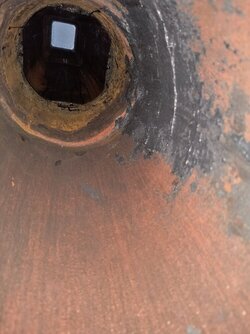
I just went up and stuffed the top 1' of the chimney with fiberglass insulation. Lower end is capped with two large towels. With both of these in place, there is still enough draft to hold a piece of paper in place. Im thinking that the condensation must be warm air meeting the cold chimney and condensing somewhere midway up the clay liner. I'm kind of stumped as to how to remedy that. It should be noted that it is a very windy day.
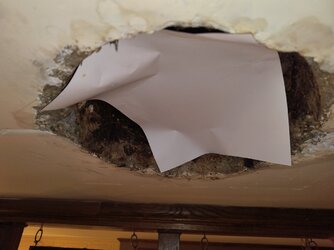

30WCF
Minister of Fire
The majority of the house is underground with just a south wall exposed. Yes, we do have a forced air electric heat pump. I turned it off and there is still a significant draft up the flue. There is no fresh air inlet on the heat pump, though I have intended to add one eventually with the addition of a whole house dehumidifier. The only intended fresh air inlet is the one for the wood stove. All doors and windows are 12 years old and are good quality. We had added on to the far end of the home with a 900 sq ft garage, built at the level of the original home. Above the garage, a second floor that is finished off and connected to the lower living area with a stairwell/hallway. The two areas share a common HVAC and return air is wild.Are you pumping air into the house somewhere? Are you underground and have a forced air supply?
Here is a pic that might help visualize the addition. It is attached at the far east side of the house.
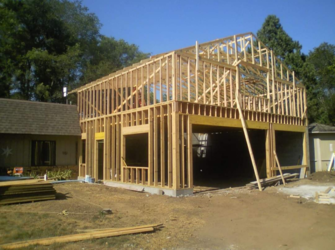
That seems crazy. You could tape a heavy duty garbage bag over the top of the chimney so no wind driven air or rain can enter or exit the chimney. That may help figure out what the real water and airflow issues are.I just went up and stuffed the top 1' of the chimney with fiberglass insulation. Lower end is capped with two large towels. With both of these in place, there is still enough draft to hold a piece of paper in place. Im thinking that the condensation must be warm air meeting the cold chimney and condensing somewhere midway up the clay liner. I'm kind of stumped as to how to remedy that. It should be noted that it is a very windy day.
View attachment 320419
That's a good idea. I was going to duct tape the top but a garbage bag may be easier. We've had no precipitation in the last week or so since I had last looked in the chimney. I'm also positive it is condensation.That seems crazy. You could tape a heavy duty garbage bag over the top of the chimney so no wind driven air or rain can enter or exit the chimney. That may help figure out what the real water and airflow issues are.
Similar threads
- Replies
- 4
- Views
- 1K
- Replies
- 4
- Views
- 491
- Replies
- 13
- Views
- 839
- Replies
- 6
- Views
- 360


